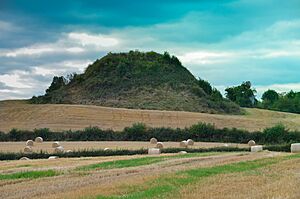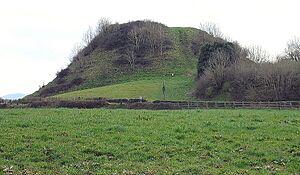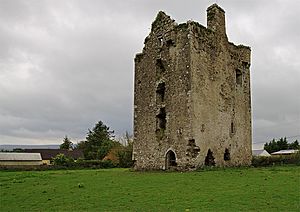Knockgraffon facts for kids
Knockgraffon (which means "Hill of the fort of Fionn" in Irish) is a small area in County Tipperary, Ireland. It's part of a larger area called a civil parish and also an ecclesiastical parish known as New Inn & Knockgraffon. This historic spot is known for its interesting features, including an old castle mound called a Motte, a church, and a castle.
Contents
Exploring Knockgraffon's Past
Knockgraffon was once a very important place, but by the 1700s, people had moved away. Around 1610, a famous Irish historian named Geoffrey Keating became the local priest here.
The Motte and Early Castles
The large earthen mound, or motte, was built by English forces in 1192. They built it next to the River Suir during a battle against the O'Sullivan clan. The King gave this land to William de Braose, 3rd Lord of Bramber, but it was later given to Philip of Worcester.
Not far from the motte, you can find the ruins of a church built in the 1200s. It has a special east window added in the 1400s. A little further away is a stone tower from the 1500s, built by the powerful Butler family.
A Place for Kings
Some historians believe Knockgraffon was a very important and sacred place in the ancient Kingdom of Munster. It might have even been where the Kings of Munster were crowned! If this is true, it would make Knockgraffon almost as important as Tara, another famous ancient site in Ireland.
One of these kings was Fíngen mac Áedo Duib, who ruled Munster until 618. His family, the O'Sullivans and MacGillycuddys, are still around today. After Fíngen died, his wife, Mór Muman, remarried. The throne of Munster eventually went to her sons from this second marriage.
The O'Sullivan Clan's Story
The O'Sullivan clan returned to Knockgraffon and became very powerful and wealthy. Their lands once included important towns like Clonmel, Cahir, Carrick-on-Suir, and Cashel. A poem from the 1400s describes the O'Sullivans ruling over vast lands around Knockgraffon, won through battles.
After the Norman invasion of Ireland in 1169, the O'Sullivan chiefs were seen as princes. They had a lot of freedom from the main ruler of Munster, the MacCarthy Mor.
Losing and Regaining Knockgraffon
However, in 1192, the O'Sullivan clan suffered a big defeat. They were forced to give up their land to the Norman invaders. The whole clan moved west to the mountains of Cork and Kerry. To make things worse, the Normans built their large earthen motte right on the O'Sullivans' sacred hill of Rath Fionn. Later, they also built a small stone castle nearby.
Donal Mor, the O'Sullivan chief at the time Knockgraffon was lost, was later killed in 1214. This happened because some people wanted to bring the throne of Munster back to Fíngen's family.
In 1998, something amazing happened: an O'Sullivan descendant, Gary Brian Sullivan from Statesboro, USA, bought the Knockgraffon motte. This was the first time Knockgraffon had been back in O'Sullivan hands in almost 800 years!
Famous People from Knockgraffon
Marian Tobin was born in Knockgraffon. She was an important woman during the Irish War of Independence. She helped hide famous Irish rebels like Dan Breen and Seán Treacy after a key event called the Soloheadbeg ambush.




